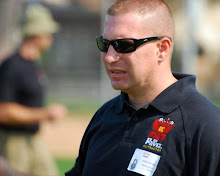Many of you already know my thoughts on the crunch. I can do them in fact I’ve been doing 200 per year! Yes, you read it correctly only 200. I complete 100 on the semi annual PFT. The crunch is a 2 minute timed event and 100 is the maximum. I finished the last 2 in about 65 seconds.
I do have one secret: when the word go is given, I don't stop. I close my eyes and go. When my partner gets to 100, I stop. I've completed 36 or more PFTs for score and monitored scores more. Believe me when I say, most of the time, the people that stop to rest, don't receive the maximum score; they fall short of the mark.
Crunches are just plain bad especially when back problems already exist. Brett Jones supports my thoughts and provides references to support the idea. Brett give some good stuff to train the core, you can read that below.
Some exercises I do to maintain and build core strength? hanging leg raises, planks, and sitting (balancing) on an exercise ball and evil wheel roll outs. Not to mention the exercises that you can read about in this blog. (Swings, snatches, front squat, renegade row...etc.)
Here is what Brett writes in yesterday's blog:
Crunches are not Core training...
I'll keep harping on this until I expire - Crunches are not core training!
This today from Eric Cressey's blog: Discussing the Bender Ball Ab Infomercial...
Eric provided this reference in regards to why crunches are a bad idea - not too mention "beyond the range" crunches...
Drake et al. The influence of static axial torque in combined loading on intervertebral joint failure mechanics using a porcine model. Clin Biomech (Bristol, Avon). 2005 Dec;20(10):1038-45.
In particular, you might want to pay attention to the following:
“Repetitive flexion-extension motions with low magnitude compressive forces have been shown to be an effective mechanism for causing disc herniations.”
Yes - crunches are an abdominal exercise but they have nothing to do with core stability or core training. And they may even be harmful - especially if you have a history of back injury and disc issues.
Here is a little article I put together for a gym that I work at:
Just Say NO to Crunches…
Brett Jones CSCS
Ask most people what they do for their “core” or abs and crunches will be the typical response. Well, with crunches being the exercise of choice why is back pain at all time high levels?
Because crunches are not a “core” exercise and they train the exact motions that can cause back pain. Confused yet?
I can hear the inner conversations – “But I thought…????”
Much emphasized and touted for their “core” and abdominal benefits crunches are not the – or should not be – the exercise of choice.
Why? According to research from Dr. Stuart McGill (backfitpro.com) and his book Ultimate Back Fitness and Performance – crunches produce very high levels of intra-disc pressure and do not train the abdominals to produce spinal stability. Your abdominals are meant to be stabilizers not movers and the rectus abdominus (the 6 pack muscle) is not really a flexor anyway. It is actually there to provide increased “hoop tension” – read resistance to twisting motions.
What’s a guy or gal to do? Learn to produce stability and prevent rotation and use the abs as stabilizers instead of movers.
Planks to the rescue! Get down on your elbows and toes and make a straight line out of your body. Pull your elbows to your toes and create a “superstiff” contraction of your abs, glutes and entire body. Breathe with and through the tension and stay tight.
Work hard – do not just hang out – and build up to a 1 minute plus hold. You can also get into plank position and keeping the body in perfect position lift one foot just a couple inches (keep the glutes tight and do not change body position at all) and hold. Rest and repeat on the other side. Side planks are also possible.
Ditch the crunches and start planking to improve your “core” stability and see an exercise specialist for questions and/or help with implementing your new “abdominal” routine.
And this is only the beginning - Core activation techniques can be used to target "core" involvement depending on the foot placement/movement pattern (symmetrical, asymmetrical or single legged) and you can get into Full Contact Twists, Chops, Lifts and Overhead lifts....
Training Today:
Swing: 200
bottoms up get up -- 16k 1/1
Pistol: 16k - 5x2/2 + 1leg DL: 5x5
Clean and Press: 32K 5x1,1,2
Why Do You Ride
13 years ago







No comments:
Post a Comment